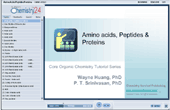Amino Acids, Peptides, and Proteins
| Topic Review on "Title": |
Amino Acids
Amino acids are the building blocks of proteins. An α-amino acid consists of a central carbon atom, called the α carbon, linked to an amino group, a carboxylic acid group, a hydrogen atom, and a distinctive R group. In neutral solution, amino acids are zwitterionic, with a positive charge on the nitrogen atom and a negative on the carboxyl group, The R group is often referred to as the side chain. With four different groups connected to the tetrahedral α-carbon atom, α-amino acids are chiral. The structure of the twenty amino acids are given. The twenty amino acids are glycine, alanine, serine, threonine, tyrosine, leucine, isoleucine, valine, cysteine, methionine, aspartic acid, asparagine, glutamic acid, glutamine, tryptophan, proline, lysine, phenylalanine, arginine, and histidine.
Peptides
Peptide bond formation is a condensation reaction leading to the polymerization of amino acids into peptides and proteins. Peptides are small consisting of few amino acids. The simplest peptide, a dipeptide, contains a single peptide bond formed by the condensation of the carboxyl group of one amino acid with the amino group of the second with the concomitant elimination of water. The process of peptide bond formation can then continue to join other amino acids and yield in an amino acid chain. A peptide chain will have an unbound amino group free at one end (called the N-terminus) and a single free carboxylate group at the other end (called the C-terminus). When there are a few amino acids in a chain (usually 10 - 20) , it is called an oligopeptide. When there are many (usually more than 20) it is called a polypeptide. Although the terms "protein" and "polypeptide" are sometimes used to describe the same thing, the term polypeptide is generally used when the molecular weight of the protein is below 10,000.
Proteins
Proteins are among the fundamental molecules of biology. Proteins are linear polymers (chains) built from a repertoire of at least twenty monomer units. There are four classes of structure: primary structure, secondary structure, tertiary structure, and quaternary structure. The primary structure of peptides and proteins refers to the linear number and order of the amino acids present. In the secondary structure, the peptide backbone has bonding between the C_O and the NBH groups, either within the chain or between chains. A helical structure is formed from intramolecular hydrogen bonding. The ß-pleated sheet is another stable form, where the hydrogen bonding is between adjacent chains. Several chains can be involved in a sheet-like structure. A protein that completely lacks secondary structure is a random coil. A tertiary structure is the interactions of hydrogen bonding, hydrophobic interactions, electrostatic interactions, and van der Waals forces. Most proteins, particularly those with molecular masses 100 kD, consist of more than one polypeptide chain. These polypeptide subunits associate with a specific geometry. The spatial arrangement of these subunits is known as a protein=s quaternary structure.
|
| Rapid Study Kit for "Title": |
| Flash Movie |
Flash Game |
Flash Card |
| Core Concept Tutorial |
Problem Solving Drill |
Review Cheat Sheet |
 |
 |
 |
|
| "Title" Tutorial Summary : |
An α-amino acid consists of a central carbon atom, called the α carbon, linked to an amino group, a carboxylic acid group, a hydrogen atom, and a distinctive R group. The structure of the twenty amino acids are given. The formation and classification of peptides are given. Dipeptides, oligopeptides, and polypeptides are defined. Proteins are classified by primary structure, secondary structure, tertiary structure, and quaternary structure.
|
| Tutorial Features: |
This tutorial provides the comprehensive coverage of the chapter with easy introduction and simple illustration. It features:
- Concept map showing interconnections of new concepts in this tutorial and those previously introduced.
- Definition slides introduce terms as they are needed.
- Visual representation of concepts.
- Use of colors to emphasis points.
- Outline of structure, and nomenclature.
- Extensive drawings of the different types of peptide structures.
- Examples worked out step-by-step throughout the tutorial.
- A concise summary is given at the conclusion of the tutorial.
|
| "Title" Topic List: |
Amino Acids
- Structure
- Coding
- Classification
- Twenty Amino Acids
Peptides
- Formation
- Classification (Dipeptide, Oligopeptide, Polypeptide)
Proteins
- Classification
- Structure (Primary Structure, Secondary Structure, Tertiary Structure, Quaternary Structure)
|
See all 24 lessons in college chemistry, including concept tutorials, problem drills and cheat sheets:
Teach Yourself Organic Chemistry Visually in 24 Hours |



